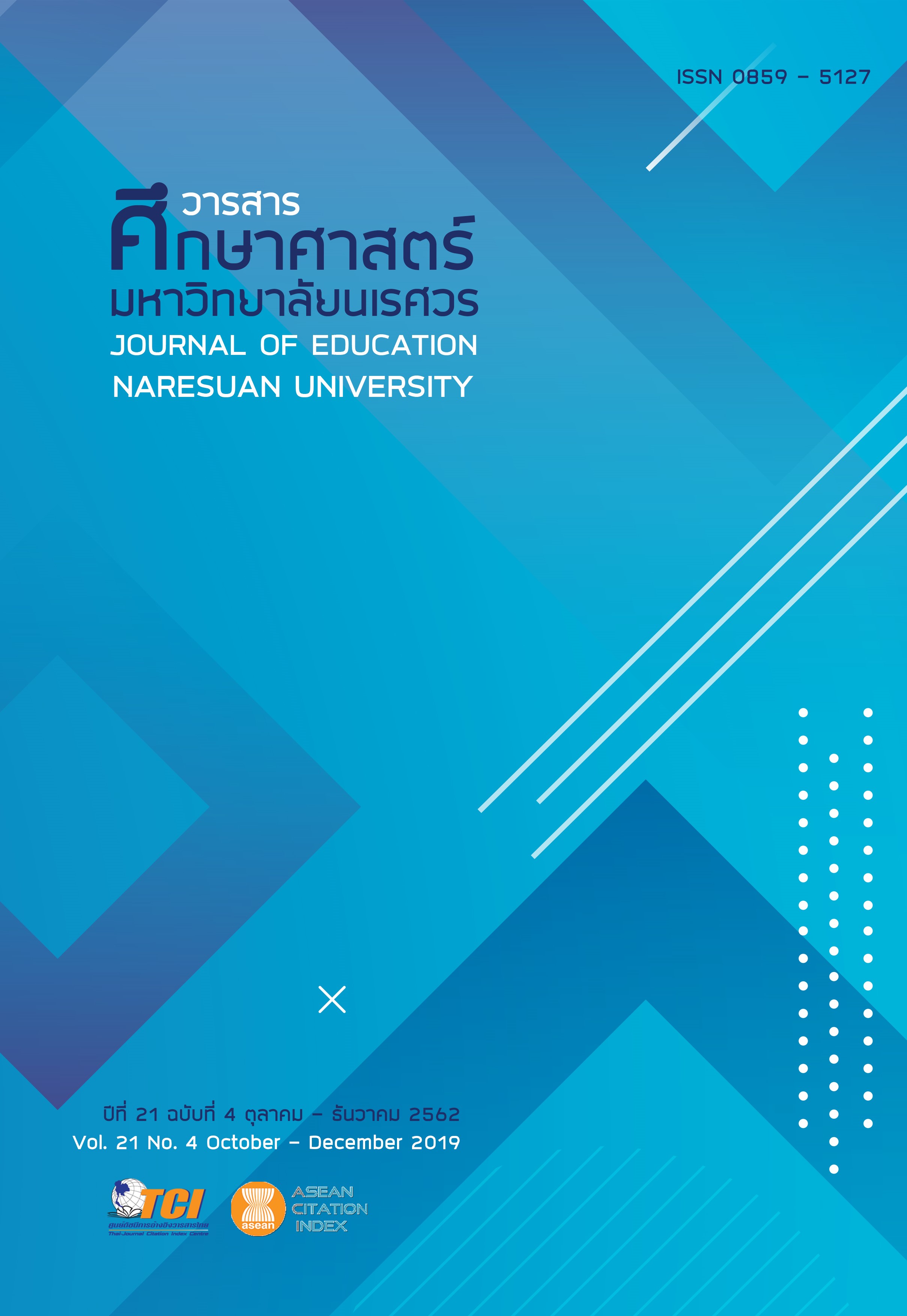การวิจัยปฏิบัติการเพื่อพัฒนาการจัดการเรียนรู้โดยใช้เคลย์แอนิเมชั่น ร่วมกับการจัดการเรียนรู้โดยใช้แบบจำลองเป็นฐานที่ส่งเสริมการพัฒนามโนทัศน์ เรื่อง ระบบย่อยอาหาร (USING ACTION RESEARCH TO DEVELOP CLAY ANIMATION WITH MODEL BASE TEACHING TO ENCOURAGE CONCEPT DEVELOPING IN THE TOPIC OF DIGESTIVE SYSTEM)
Main Article Content
Abstract
การวิจัยนี้เป็นงานวิจัยปฏิบัติการ มีวัตถุประสงค์เพื่อพัฒนาการจัดการเรียนรู้โดยใช้เคลย์แอนิเมชั่น เรื่อง ระบบย่อยอาหาร ผู้เข้าร่วมวิจัยเป็นนักเรียนชั้นมัธยมศึกษาปีที่ 4 จำนวน 38 คน ผู้สอนใช้รูปแบบการวิจัยปฏิบัติการในชั้นเรียน ประกอบด้วย 4 ขั้น ได้แก่ ขั้นวางแผน ขั้นปฏิบัติ ขั้นสังเกต และขั้นสะท้อนผล รวมทั้งหมด 3 วงรอบ เครื่องมือที่ใช้ในการวิจัย ได้แก่ แผนการจัดการเรียนรู้ การสังเกตแบบมีส่วนร่วม แบบสะท้อนผลการจัดการเรียนรู้ และชิ้นงานวีดิทัศน์เคลย์แอนิเมชั่น โดยใช้การวิเคราะห์ข้อมูลเชิงเนื้อหา และการตรวจสอบความน่าเชื่อถือข้อมูลแบบสามเส้า จากผลการวิจัยครั้งนี้ พบว่า การประยุกต์ใช้การจัดการเรียนรู้โดยใช้เคลย์แอนิเมชั่น ควรปฏิบัติตามขั้นตอนการจัดการเรียนรู้ ดังนี้ 1) ขั้นนำเข้าสู่บทเรียน ผู้สอนควรเลือกคลิปวีดิทัศน์ที่นำเสนอเกี่ยวกับเหตุการณ์ที่เป็นปัจจุบัน ทั้งนี้เพื่อกระตุ้นให้นักเรียนสนใจในมโนทัศน์ที่กำลังจะศึกษา 2) ขั้นวางแผนและสำรวจ นักเรียนวางแผนและสำรวจข้อมูล เพื่อตรวจสอบมโนทัศน์วิทยาศาสตร์ ทั้งนี้ผู้สอนต้องเน้นให้นักเรียนใช้แหล่งข้อมูลที่มีความน่าเชื่อถือ 3) ขั้นสะท้อนความคิด นักเรียนสะท้อนความเข้าใจเกี่ยวกับมโนทัศน์ผ่านการสร้างแบบจำลองดินน้ำมัน และเคลย์แอนิเมชั่น 4) ขั้นนำความรู้ไปใช้ นักเรียนร่วมกันอภิปรายและสรุปมโนทัศน์ที่ได้จากการดูวีดิทัศน์เคลย์แอนิเมชั่น หลังการจัดการเรียนรู้ พบว่า นักเรียนเข้าใจมโนทัศน์ย่อย เรื่อง ระบบย่อยอาหารของคนสูงที่สุด
USING ACTION RESEARCH TO DEVELOP CLAY ANIMATION WITH MODEL BASE TEACHING TO ENCOURAGE CONCEPT DEVELOPING IN THE TOPIC OF DIGESTIVE SYSTEM
This qualitative research aims to develop using clay animation in the topic of digestive system. There were 38 grade 10th students participated in this research. Three cycles of action research consisted 4 steps: plan, act, observe, and reflect was utilized research design. Research instrument included lesson plans, reflective journals. Research data were analyzed by used content analysis. Method and resource triangulations were implemental to indicate data creditability. The research found that teaching with clay animation needed 4 phases as follows: 1) Engagement phase teacher introduced students by a video clip presented current situation of scientific concept, so that stimulated students’ interest in the scientific concept, 2) exploration and design phase students designed and investigated information to examine the scientific concept and the teacher must remind students used credibly informational sources, 3) notion reflects phase students showed their understanding in the scientific concepts through construction of clay model and clay animation, and 4) apply knowledge phase students discussed and concluded about the scientific concepts reflected through clay animation.
Article Details
The owner of the article does not copy or violate any of its copyright. If any copyright infringement occurs or prosecution, in any case, the Editorial Board is not involved in all the rights to the owner of the article to be performed.
References
2. Halloun, I. A. (2011). From modeling schemata to the profiling schema: Modeling across the curricula for profile shaping education. In M. S. Khine & I. M. Saleh (Eds.), Models and modeling in science education (pp. 77-78). U.K.: Springer Dordrecht Heidelberg London New York.
3. Kampiwtha, C. (2016). The development of scientific reasoning through the generate an argument instructional model in digestive system topic for 10th grade students (Master thesis). Phitsanulok: Naresuan University. [in Thai]
4. Kemmis, S. (1988). Action Research in Retrospect and Prospect. In S. Kemmis and R. McTaggart (Eds.). The Action Research Reader 3rd ed. (pp. 27-39). Geelong, Victoria: Deakin University Press.
5. Kijkuakul, S. (2014). Science learning management for teachers in 21st century. Phetchabun: Junraditkranpim. [in Thai]
6. Nuangchalerm, P. (2015). 21st century learning in science. Bangkok.: Active Print. [in Thai]
7. Pitiporntapin, S., & Sritha, S. (2012). The outcomes of biology learning management in the topic of cell division with creating Clay animation- stop motion by 10th grade students. Kasetsart Journal (Soc. Sci), 33(3), 397-409. [in Thai]
8. Posner, G. J., Strike, K. A., Hewson, P. W., & Gertzog, W. A. (1982). Accommodation of a scientific conception: Toward a theory of conceptual change. Science Education, 66(2), 211-227.
9. Sangsit, T. (2012). Mental representation study of grade 12 students on electrochemical cell by creating Clay animation model with analogy (Master thesis). Khon Kaen: Khon Kaen University. [in Thai]
10. Suphatchaiwong, P., Faikhamta, C., & Suwanruji, P. (2015). Using model-based learning for enhancing mental model of atomic structure and understandings of the nature of model of 10th grade students. Learning of Innovation Journal, 1(1), 97-124. [in Thai]
11. Verhoeff, P. R., Waarlo, J. A., & Boersma, T. K. (2008). Systems modelling and the development of coherent understanding of cell biology. International Journal of Science Education, 30(4), 543-568.


